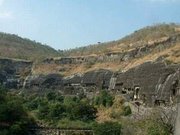Ajanta
|
|
Template:World Heritage Sites in India
Ajanta (more properly Ajujnthi), a village in the erstwhile dominions of the Nizam of Hyderabad in India and now in Buldhana district in the state of Maharashtra(N. lat. 20 deg. 32' by E. long. 75 deg. 48') is celebrated for its cave hermitages and halls. As of 1983, the Ajanta Caves have been an UNESCO World Heritage Site specifically nominated for the international World heritage program.
The caves are in a wooded and rugged horseshoe-shaped ravine about 3 1/2 m. from the village. Along the bottom of the ravine runs the river Wagura, a mountain stream, which forces its way into the valley over a bluff on the east, and forms in its descent a series of waterfalls, 200 ft. high, the sound of which must have been constantly audible to the dwellers in the caves. These are about thirty in number, excavated in the south side of the precipitous bank of the ravine, and vary from 35 to 110 ft. in elevation above the bed of the torrent.
The monastic complex of Ajanta consists of several viharas (dwelling halls) and chaitya-grihas (stupa halls) cut into the mountain scarp in the fifth century CE. The viharas had a broad verandah, its roof supported by pillars, and giving towards the interior on to a hall averaging in size about 35 ft. by 20 ft. To left and right, and at the back, dormitories are excavated opening on to this hall. The number of dormitories varied according to the size of the hall, and in the larger ones pillars supported the roof on all three sides, forming a sort of cloister running round the hall. The viharas incorporated a shrine to house an image of the Buddha in a niche facing the entrance and sometimes subsidiary shrines to the right or left of the entrance. The facades of the viharas were decorated with carvings and walls and ceilings were often covered with paintings (Mitra 1971). Changes in Buddhist thought in the first century BCE had made it possible for the Buddha to be deified and consequently the image of the Buddha as a focus of worship became popular (Dehejia 1997).
The chaitya-grihas go back into the rock about twice as far as the viharas, the largest being 94 1/2 ft. from the verandah to the back and 41 1/4 ft. across, including the cloister. The chaitya-grihas at Ajanta continued to enshrine stupas, but generally they now had a standing or seated image of the Buddha in front of them. Another aspect of changing patterns of worship is the bodhisattva cult that was practised at Ajanta. Bodhisattvas are celestial compassionate beings on the threshold to Buddhahood that chose to remain in the world to help others towards salvation (Dehejia 1997). These bodhisattvas were often depicted as sculptures at the entrance of a vihara or chaitya-griha or on wall-paintings.
Ajantamural.jpg
The caves are in three groups, the oldest group being of various dates from 200 BCE to CE 200, the second group belonging, approximately, to the sixth and the third group to the seventh century. Most of the interior walls of the caves were covered with murals. When first discovered in 1817, they were in a fair state of preservation, but they have since deteriorated. Fortunately, the school of art in Bombay, especially under the supervision of J. Griffiths, had copied in colours a number of them before the last vestiges had disappeared, and other copies of certain of the paintings have also been made. These copies are invaluable as being the main evidence of pictorial art in India before the rise of Hinduism.
| Missing image Dharma_wheel_1.png Dharma wheel Buddhism |
| Culture |
| History |
| List of topics |
| People |
| By region and country |
| Schools and sects |
| Temples |
| Terms and concepts |
| Texts |
| Timeline |
The expression Cave Temples used by Anglo-Indians of such halls is inaccurate. Ajanta was a kind of college monastery. Hsuan Tsang informs us that Dinnaga, the celebrated Buddhist philosopher and controversialist, author of well-known books on logic, resided there. In its prime the settlement must have afforded accommodation for several hundreds, teachers and pupils combined. Very few of the subjects have been identified, but two are illustrations of stones in Arya Sura's Jataka Mala, as appears from verses in Sanskrit painted beneath them.
References
Burgess, J. and Indraji, B. (1881). Inscriptions from the Cave Temples of Western India. Bombay
Burgess, L. and Fergusson J. (1880). Cave Temples of India. London.
Dehejia, V. (1997). Indian Art. Phaidon: London. ISBN 0714834963.
Griffiths, J. (1896-1897). Paintings in the Buddhist Cave Temples of Ajanta. 2 vols. London.

